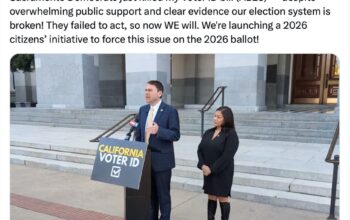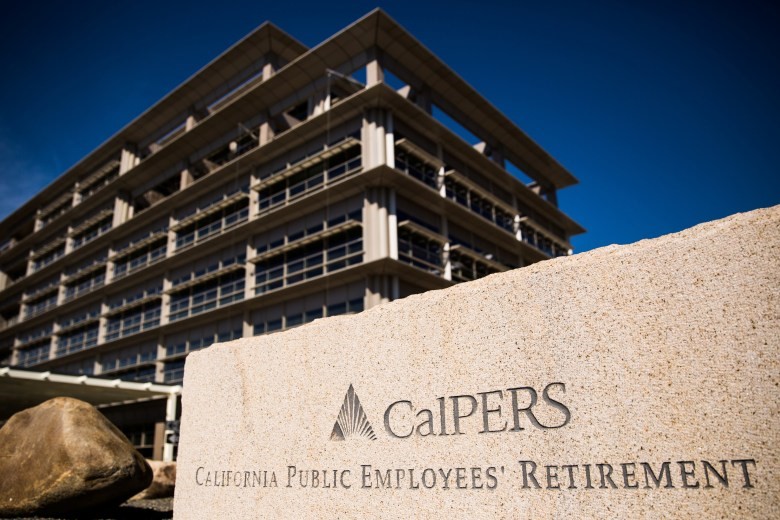California is no longer the Golden State—it is the KKK State. Our children instead of getting history lessons are being taught to hate, to be bigots and for the white students, they are learning they are maggots in history and do not deserve to live.
“When all is said and done, the material emphasizing whites’ subjugation of non-whites is not a conventional textbook subject, but an ideology with an activist political agenda. Revisions may never satisfy parents and teachers who believe public schools shouldn’t be in the business of teaching kids how to develop a “social consciousness” or using class time to pinpoint a student’s intersectional identity to determine where they fit on a hierarchy of power.
At the same time, ethnic studies activists are furious that their efforts at promoting social justice, and centering “voices of color” are being diluted by, as they put it, power structures such as “whiteness,” Zionism and assimilationism.
Passage of the landmark curriculum at the board’s scheduled meeting on March 18 should mark a hard-fought victory for the half-century-old ethnic studies movement and help advocates promote their movement across the country. But it will not end the conflict in California, where the issue will be forced to the local level to be decided by local schoolboards or in individual classrooms.
If you are a white, Jewish student, you are the lowest of the low. The good news is that in November, 2022 we will get a chance to free our kids from the KKK/union run government schools.

By John Murawski,, RealClearInvestigations, 3/10/21
California has struggled for five years to create a politically palatable “ethnic studies” curriculum that would teach high schoolers how systemic racism, predatory capitalism, heteropatriarchy and other “structures of oppression” are foundational to American society.
Now, after more than 82,000 public comments, and four major rewrites, the state Board of Education is expected to approve the latest version next week, clearing the way for lawmakers to make a semester-long course in the material a graduation requirement for all of California’s 1.7 million high school students.
The latest curriculum, however scaled back, still shares similarities with an earlier, rejected draft that a top state official said failed to comply with state law, and the Los Angeles Times editorial board characterized as a jumble of “politically correct pronouncements” that feel like “an exercise in groupthink, designed to proselytize and inculcate more than to inform and open minds.”
When all is said and done, the material emphasizing whites’ subjugation of non-whites is not a conventional textbook subject, but an ideology with an activist political agenda. Revisions may never satisfy parents and teachers who believe public schools shouldn’t be in the business of teaching kids how to develop a “social consciousness” or using class time to pinpoint a student’s intersectional identity to determine where they fit on a hierarchy of power.
At the same time, ethnic studies activists are furious that their efforts at promoting social justice, and centering “voices of color” are being diluted by, as they put it, power structures such as “whiteness,” Zionism and assimilationism.
Passage of the landmark curriculum at the board’s scheduled meeting on March 18 should mark a hard-fought victory for the half-century-old ethnic studies movement and help advocates promote their movement across the country. But it will not end the conflict in California, where the issue will be forced to the local level to be decided by local schoolboards or in individual classrooms.
The reason: The state’s guidelines grant teachers wide flexibility in how they teach the subject. Ethnic studies activists — including those who wrote the first, rejected draft of the curriculum — say high school teachers will have an escape clause to teach a watered down version that the activists deride as a “Foods, Heroes & Holidays” and “all lives matter” pabulum. These advocates insist on hewing to a heroic narrative about how people of color have suffered from and fought against European capitalism, colonialism, and imperialism.
Practitioners have formed their own organization – the Liberated Ethnic Studies Model Curriculum Institute – to promote an “authentic” ethnic studies, a discipline born in the late 1960s out of student campus protests led by the Third World Liberation Front to end Eurocentrism in education.
For the past year, these activists have been meeting in online sessions to hash out strategy, expound upon their “liberatory” and “transformational” ideology, and encourage educators to teach the full-strength curriculum that the state has flunked. Their unguarded comments in numerous videos convey the combative tone and spirit of ethnic studies already evident in some California classrooms, and likely to be adopted by many more teachers regardless of the model curriculum approved by the state.
“Inside of the United States, native people have been actively fighting a long war to dismantle the United States,” said Stevie Ruiz, who teaches in the Department of Chicana and Chicano Studies at the California State University, Northridge, during a May 2020 online strategy session.
“So then we can actually think about what happens if we honor native people’s acknowledgements and begin to tear apart the United States internally,” continued Ruiz, who was listed as one of the leaders of the Liberated group until February. “What if we decide to call this place the United States no longer?”
‘A Way of Life’
The Liberated Ethnic Studies group includes many of the original authors of the 2019 Ethnic Studies Model Curriculum that the state has gutted, as well as 50 scholars, teachers, practitioners and students, according to Allyson Tintiangco-Cubales, an Asian American Studies professor at San Francisco State University, speaking during a Feb. 2 online event. The advocates say that many state officials fail to grasp that ethnic studies is not a traditional school subject, but a movement and a philosophy best described as “narrative medicine,” “radical healing” and even a “way of life.” It’s distinguished from traditional classroom instruction by its emotional, immersive pedagogy designed to deprogram kids from European cultural assumptions, to make teenagers conscious of systemic inequities, and to reconnect them with forgotten ancestral knowledge.
According to one of the Liberated institute leaders, Theresa Montaño, a professor of Chicana and Chicano studies at the California State, Northridge, the group’s K-12 lesson plans should be available online for free this spring.
According to the group’s web site, the material will be based on five themes: racialized intersectional identity, collective narratives, systems of power and oppression, resilience and resistance, and solidarity among people of color. And the Liberated institute is open for business: “We have packages and experts that can help you with your Ethnic Studies professional learning needs.”
“We know that when districts begin to implement their ethnic studies programs, they’re not going to go to the state of California and say, ‘Excuse me, state of California, can you come to L.A. and help me implement my ethnic studies program?’” Montaño said last August. “No, they’re going to come to us. And so we are continuing the work that we need to do to develop ethnic studies while simultaneously holding on to some critical hope that we can still influence what the state of California does.”
In repeated expressions of frustration, the advocates attribute the state’s political compromises to a common enemy: “whiteness” – what they call the oppressive force that their movement and its precursors have been seeking to disempower for 500 years. “All of the attacks against the ESMC [Ethnic Studies Model Curriculum] came from the realms of whiteness and authoritarian whitesplaining,” read a statement Los Angeles public school intervention counselor Guadalupe Carrasco Cardona posted during her May presentation on ethnic studies and teacher preparation.
Guadalupe Carrasco Cardona: This “proud member of the socialist political organization, Union del Barrio” argues the attacks on her activist-backed curriculum “came from the realms of whiteness and authoritarian whitesplaining.”
guadalupecardona.com
“Well-funded attempts at whitewashing the ESMC ranged from right wing white nationalists at Breitbart, to Wall Street Journal white capitalists who deny the climate crisis, to white moderates who superficially may say they support ethnic studies, but only if it’s done in the way they ‘as gate-keeping white moderates’ say it needs to be done.”
The model curriculum that Cardona, Montaño, Tintiangco-Cubales and others wrote in 2019 hit a tripwire with references to Palestinian resistance to the state of Israel as an example of ethnic studies in action. The removal of those references from the state’s revised curriculum, and the addition of lessons about anti-Semitism, is seen by the advocates as emblematic of the way white power structures erase the histories of those they oppress.
Cardona, one of the founding members of the Liberated Ethnic Studies group, said by phone that she expects an anti-Israel Boycott, Divestment, and Sanctions lesson to be included in the Liberated materials that the group is developing.
Cardona is a longtime public school teacher and a veteran of California’s ethnic studies skirmishes, having been fired from a teaching position three years ago after some parents found out she was a member of a Marxist organization that advocates for political revolution, emulates Cuba’s Fidel Castro and Venezuela’s Hugo Chavez, and vows “to crush all forms of oppression and reactionary tendencies.”
Rejecting the state’s assimilationist bent, Cardona suggested that ethnic studies has a totally different focus than the current equity push to get people of color into middle management positions.
“They just want little youth to want this little piece of this American pie because that’s what they think social justice is: put black, brown, indigenous bodies in college, put them into these corporate positions and have them do the same old thing that this country does,” she said in a May podcast. “And we’re saying, No, there’s something wrong with this system. We want black, brown and indigenous bodies in universities to learn about it and to transform and to end all of this oppression, not to continue the roles of the oppressor.”
Another flash point in the 2019 model curriculum was the exclusive focus on people of color, with no mention of European ethnicities that were subject to discrimination and genocide. The experiences of European groups, including Jews and Armenians, deserve to be studied, the advocates say, but they have no connection to the ethnic studies movement, whose true focus is the worldview and struggle of people of color against white supremacy.
The sweeping 1,000-plus pages of the state’s revised model curriculum and appendices have toned down the language of the original version, but the public comments cite a number of concerns.
Judea Pearl, father of the late Daniel Pearl, a Wall Street Journal reporter beheaded by Al Qaeda terrorists, wrote: “I am particularly alarmed by its attempt to depict inter-ethnic relationships as a[n] irreconcilable struggle between racially-defined ‘oppressed’ and [‘]oppressors,’ and by the way it associates ‘whiteness’ with ‘oppression’ and ‘colonialism.’”
According to one of several definitions of “race” provided, American society comprises two opposing racial factions: “In the United States today, races very broadly break down as people of color (POC) and white people.” That definition comes from Rethinking Ethnic Studies, a primer co-edited by R. Tolteka Cuauhtin, a consultant and one of the authors of the rejected 2019 version of the model curriculum.
Breaking New Ground
The state’s Department of Education described its ethnic studies undertaking in the previous draft as “a groundbreaking project – the first of its kind among the 50 states.” And given California’s outsize influence in the textbook industry and educational trends, it is assumed by many in the field that California’s standards could serve as a national model for years to come.
California’s push to make a semester-long ethnic studies class a graduation requirement for all of its 1.74 million high school students in 1,322 high schools would be an exponential expansion for a course taught to 20,500 students in 314 high schools during the 2018-19 academic year.
Ethnic studies advocates believe that after four years of President Donald Trump, a pandemic that hit minorities hard, and a summer of Black Lives Matter demonstrations, Americans are ready to grapple with the moral implications of the nation’s origins and history.
“All the horrific shit that white people have been doing to us, has now began to haunt them,” Ruiz told his colleagues in the May video. “Because they’ve been experimenting on us for 500 years, it’s no longer something you can contain anymore.”
They also see encouraging signs in President Biden’s choice of education secretary, Miguel Cardona, considered a champion of the cause who will be well positioned to put federal muscle behind it. As Connecticut’s commissioner of education last year, Cardona oversaw that state’s adoption of a requirement that all high schools offer courses in African American, Black, Puerto Rican, and Latino studies.
“For Ethnic Studies advocates, that’s really encouraging and suggests that maybe we might see some national efforts that are encouraging folks to implement Ethnic Studies in the K-12 setting,” said Ravi Perry, chairman of Howard University’s political science department and immediate past president of the Association for Ethnic Studies.
“Education is a local issue,” Perry said. “But perhaps like they’ve done with transgender bathroom directives in the Obama administration, they can provide some incentives, some strongly worded language to districts, to encourage them to adopt this curriculum while working behind the scenes in the House and Senate to get a bill passed that would perhaps require this [nationally].”
There’s no way of getting around the fact that ethnic studies is going to make some people uncomfortable.



